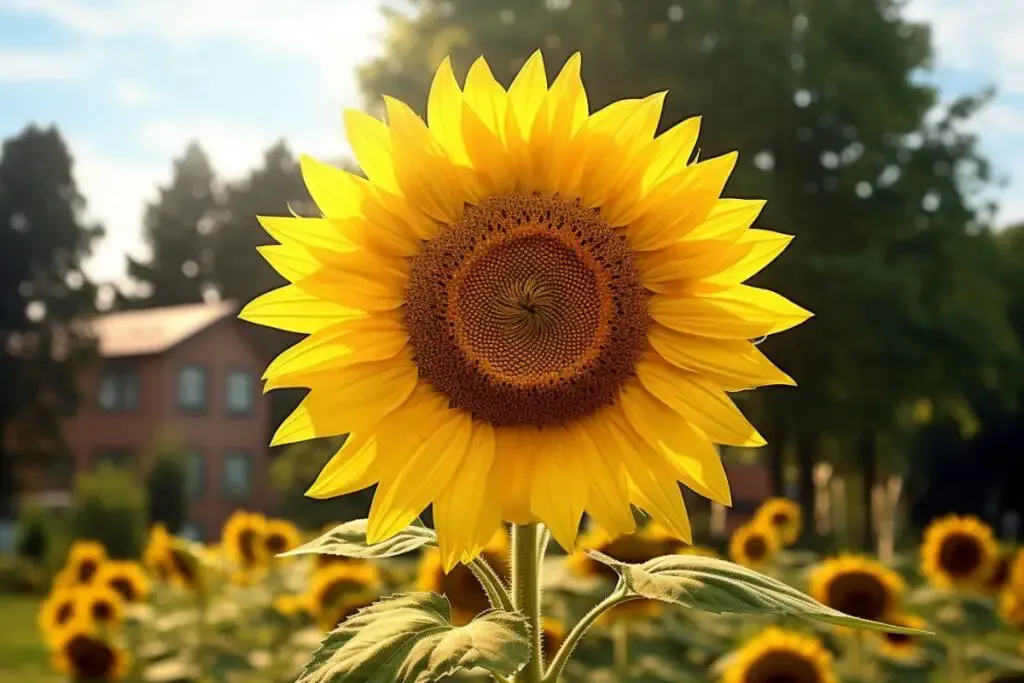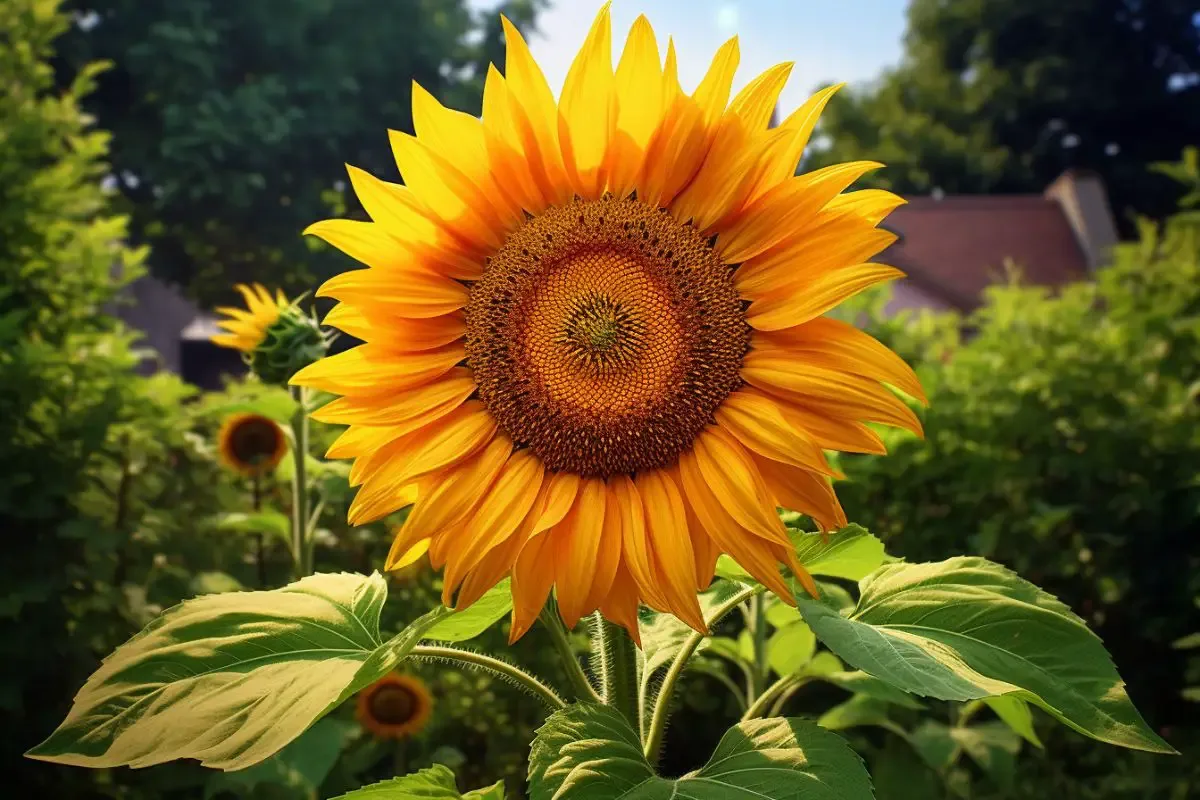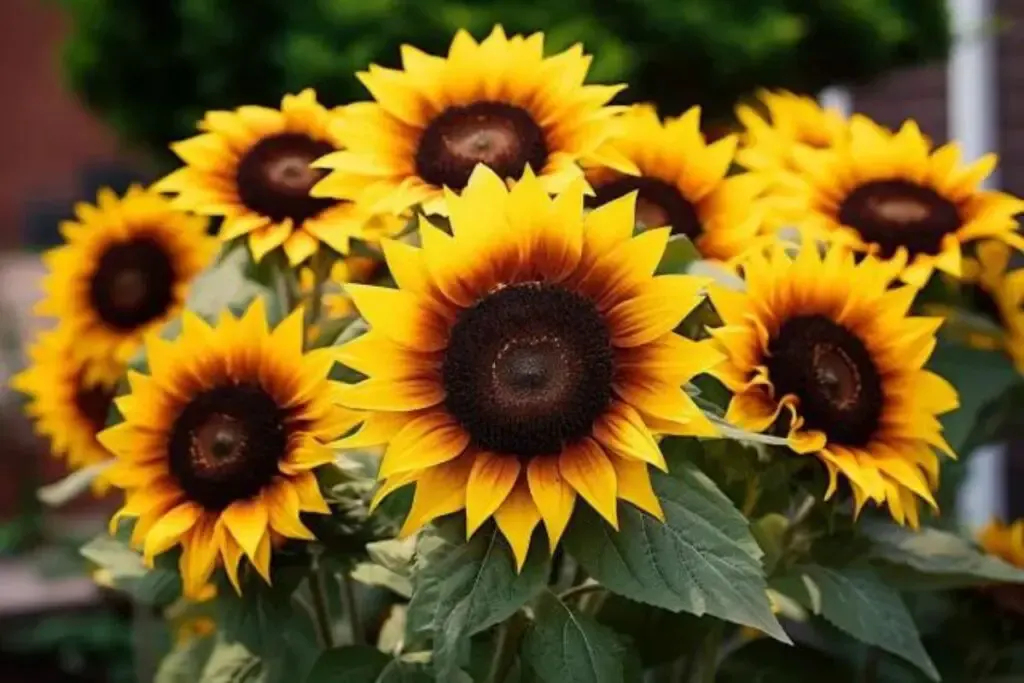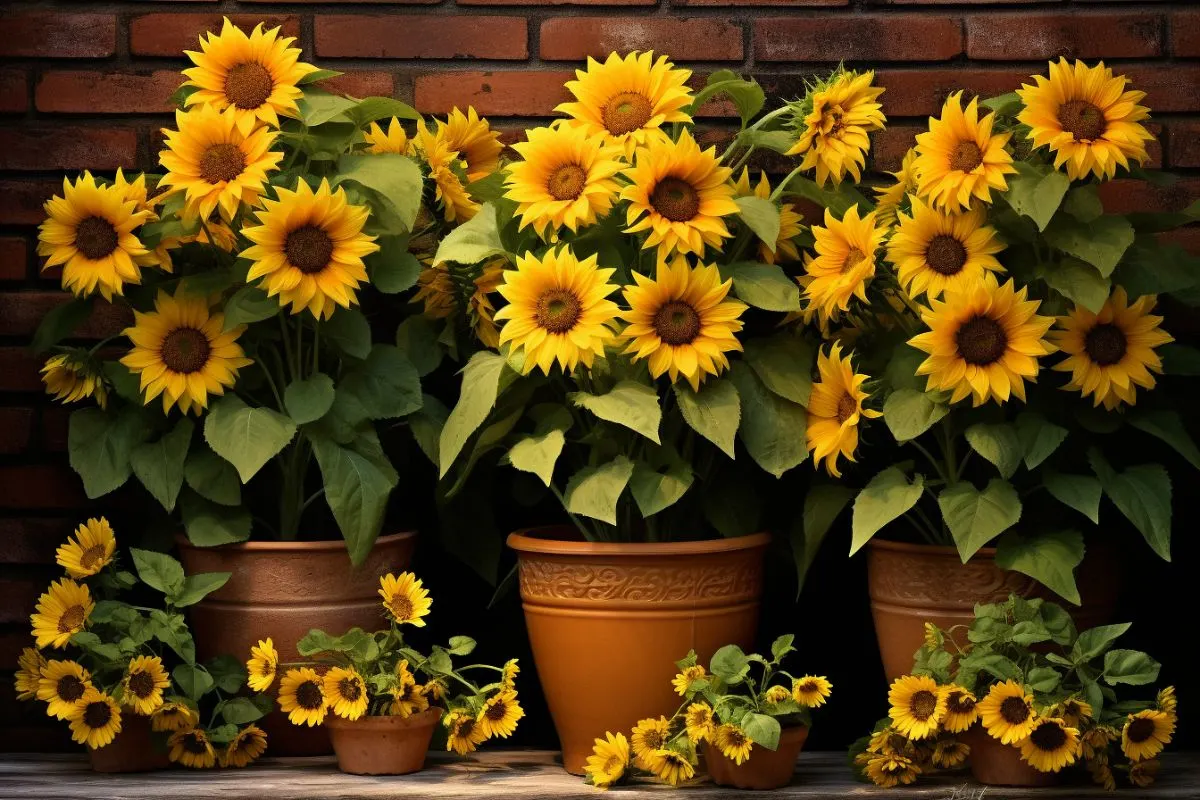Sunflowers are one of the most iconic and recognizable flowers in the world, known for their large, vibrant blooms that seem to exude happiness and warmth.
These stunning flowers are not just a feast for the eyes, but they also offer a range of benefits for both the garden and the gardener.
In this article, we will delve into the world of sunflowers, exploring their benefits, some of my favorite varieties, and how you can successfully grow and care for them in your own garden.
Benefits of Growing Sunflowers

Sunflowers are more than just a pretty face; they bring a plethora of advantages to your garden. Here are three top benefits of growing these cheerful blooms:
1. Attracting Pollinators
Sunflowers are a magnet for bees, butterflies, and other pollinating insects. The large, open faces of the flowers provide an easy and accessible source of nectar and pollen, helping to support local pollinator populations.
This, in turn, can lead to better pollination of other plants in your garden, resulting in a more bountiful harvest.
2. Improving Soil Health
Sunflowers are known for their ability to absorb toxins from the soil, including heavy metals like lead and cadmium. By planting sunflowers, you can help to cleanse and rejuvenate the soil in your garden, leading to healthier plants overall.
Additionally, the deep roots of sunflowers help to break up compacted soil, improving its structure and drainage.
3. Providing Food and Habitat
The seeds of sunflowers are a favorite among birds, particularly finches. By growing sunflowers, you can provide a valuable source of food for local wildlife, helping to support biodiversity in your garden.
Additionally, the tall stalks and large leaves of sunflowers offer shelter and habitat for a variety of creatures.
My Favorite Sunflower Varieties
With so many different varieties of sunflowers available, it can be tough to choose just a few favorites. However, after years of gardening and experimenting with different types, here are three that stand out to me:
1. ‘Mammoth’ Sunflower

As the name suggests, this variety produces enormous flowers that can reach up to 12 inches in diameter. The tall stalks, which can grow up to 12 feet high, make a dramatic statement in the garden and are perfect for creating a natural screen or backdrop.
The seeds are also large and easy to harvest, making this a great variety for those looking to collect seeds for bird food or planting the following year.
2. ‘Autumn Beauty’ Sunflower

This variety features stunning blooms in shades of red, orange, and yellow, creating a warm and inviting display in the garden.
The multi-branching habit of ‘Autumn Beauty’ means that each plant produces multiple flowers, providing a longer-lasting display than single-stalk varieties.
3. ‘Teddy Bear’ Sunflower

For something a bit different, ‘Teddy Bear’ sunflowers are a charming, dwarf variety that grows to around 2-3 feet in height.
The fluffy, golden-yellow blooms are reminiscent of a teddy bear’s fur, making this a favorite among children and adults alike. ‘Teddy Bear’ sunflowers are perfect for growing in pots or at the front of a border, where their cute and cuddly appearance can be fully appreciated.
Sunflower Care
Sunflowers are renowned for their ease of care and hardiness, making them a fantastic choice for gardeners of all experience levels. However, like all plants, they do have specific needs that must be met in order to thrive.
Here’s a comprehensive guide on how to care for your sunflowers, from planting to fertilization.
Planting

To ensure a strong start for your sunflowers, plant the seeds directly in the ground after the last frost of the season. Choose a location that receives full sunlight for the majority of the day. Sow the seeds about an inch deep in the soil, spacing them about 6 inches apart.
If you’re planting a taller variety like the ‘Mammoth’ sunflower, be sure to give them plenty of space, as they can grow quite large. Water the seeds well after planting and keep the soil consistently moist until the seeds germinate and the seedlings are established.
Light
Sunflowers, true to their name, are lovers of light. They require full sun to reach their full potential. This means choosing a spot in your garden that receives at least 6-8 hours of direct sunlight daily.
It’s fascinating to observe how sunflowers track the sun across the sky, a behavior known as heliotropism. This solar tracking helps maximize the plant’s energy absorption, leading to healthier and more robust blooms.
If your garden has areas that are partially shaded, consider placing your sunflowers where they will receive the most consistent sunlight throughout the day.
Soil
Sunflowers aren’t particularly fussy about soil, but they do best in well-draining soil with a pH between 6.0 and 7.5. If your soil is heavy clay or sand, consider amending it with organic matter to improve drainage and fertility.
Sunflowers are quite adept at extracting nutrients from the soil, so they can thrive even in less-than-ideal conditions.
Water
While sunflowers are somewhat drought-tolerant, they do need consistent moisture, especially during their growing period.
Water your sunflowers deeply once a week, providing more frequent watering during periods of extreme heat or drought. Be mindful not to overwater, as sunflowers do not like to sit in soggy soil.
Temperature and Humidity
Sunflowers are quite adaptable when it comes to temperature and humidity. They thrive in warm conditions and are fairly tolerant of high temperatures, making them perfect for summer gardens.
Typically, they grow best in temperatures between 70°F and 78°F. Sunflowers aren’t too fussy about humidity; however, good air circulation is important, especially for tall varieties, to prevent fungal diseases.
During the initial growth stages, make sure to protect young plants from late spring frosts, as they can be sensitive to sudden cold snaps.
Fertilizer
When it comes to fertilizing sunflowers, moderation is key. These plants are not heavy feeders, but they do benefit from a boost of nutrients, especially in poor soil conditions.
I recommend using a balanced, slow-release fertilizer at the time of planting. If your soil is particularly nutrient-rich, you might not need additional fertilization. Over-fertilizing can cause lush foliage at the expense of blooms, so it’s important to strike the right balance.
For larger varieties like ‘Mammoth’, an extra feeding mid-season can support their substantial growth.
Harvesting Sunflowers
Harvesting sunflowers is one of the most rewarding parts of growing these magnificent plants. Whether you’re harvesting the seeds or enjoying the blooms indoors, timing is key. For seed harvesting, wait until the flower head has fully matured and the back of the bloom has turned brown.
You can cover the flower head with a cheesecloth or paper bag to protect the seeds from birds. Once ready, cut the stem about a foot below the flower head and hang it upside down in a dry, well-ventilated area to fully dry out. When the seeds are dry, you can rub them off the head and store them in an airtight container.
Pruning
Pruning isn’t a major requirement for sunflowers, but it can be beneficial, particularly for branching varieties. Deadheading, or removing spent flowers, can encourage more blooms and extend the flowering period.
For taller, single-stem varieties, removing lower leaves can help direct energy to the top of the plant, enhancing the size and quality of the main bloom. Regular inspection and removal of damaged or diseased foliage also help maintain the health and appearance of the plant.
Remember, pruning should be done with care to avoid damaging the main stem.
Propagating
Propagating sunflowers is typically done through seeds. Each flower head can produce hundreds of seeds, which can be saved and planted the following year. To collect seeds, wait until the flower heads droop and the back of the head turns brown.
Harvest the seeds by rubbing your hand over the face of the flower. Store the seeds in a cool, dry place until you’re ready to plant them. Propagation through seeds is a fun and educational activity, especially for kids, as it teaches them about the life cycle of plants.
How to Grow Sunflowers From Seed
Growing sunflowers from seed is a simple and rewarding process. Start by choosing a sunny location with well-draining soil. Sow the seeds about an inch deep in the soil, spacing them according to the variety’s specifications.
Water the seeds well and keep the soil consistently moist until the seedlings emerge. Once the seedlings are established, water them deeply once a week, and provide a balanced fertilizer at the time of planting. With the right care, your sunflowers will bloom in just a few short months.
Growing in Pots

Sunflowers can also be grown in pots, making them a great option for those with limited space. Choose a large pot with drainage holes and fill it with a high-quality potting mix. Sow the seeds directly in the pot, following the same planting instructions as for garden-grown sunflowers.
Be sure to choose a dwarf variety, as larger varieties may become top-heavy and tip over. Water the sunflowers regularly, keeping the soil consistently moist, and provide a balanced fertilizer at the time of planting. With the right care, you can enjoy the beauty of sunflowers, no matter the size of your space.
Overwintering
Sunflowers are generally considered annual plants, meaning they complete their life cycle in one growing season and do not survive through winter. However, if you live in a region with mild winters, or if you are growing sunflowers in pots indoors, there are some steps you can take to help your sunflowers survive through the colder months.
Firstly, it’s crucial to provide adequate protection from frost. If your sunflowers are in pots, move them to a sheltered location such as a garage or indoors. For sunflowers in the ground, you can cover them with frost cloth or burlap to provide insulation.
You should also reduce watering during the winter months, as sunflowers require less water when they are not actively growing. Be careful not to let the soil dry out completely, but also avoid overwatering which can lead to root rot.
Finally, sunflowers grown in pots should be repotted every couple of years to refresh the soil and provide additional nutrients. When repotting, be sure to choose a pot that is at least 2 inches larger in diameter than the current pot, and use a high-quality potting mix.
Transplanting
Transplanting sunflowers can be a delicate process, as they have long taproots that can be easily damaged. If you need to transplant sunflowers, it is best to do so when they are young seedlings, before their roots have had a chance to become too established.
When transplanting, be sure to dig a deep hole that can accommodate the entire root system. Gently lift the sunflower from its current location, being careful not to damage the roots, and place it in the new hole. Fill in around the roots with soil, and water well to help settle the soil.
It’s important to note that sunflowers do not always respond well to transplanting, and it can cause them to become stunted or fail to thrive. If possible, it’s best to sow sunflower seeds directly in their final location to avoid the need for transplanting.
Common Pests & Diseases
Sunflowers are relatively hardy plants, but they can be susceptible to certain pests and diseases. Some of the most common pests include aphids, spider mites, and caterpillars. These pests can be controlled with insecticidal soap or neem oil, or by introducing beneficial insects such as ladybugs or lacewings to your garden.
In terms of diseases, sunflowers can be affected by powdery mildew, rust, and downy mildew. These diseases thrive in humid conditions, so it’s important to provide good air circulation around your sunflowers and avoid overhead watering. Infected leaves should be removed and disposed of, and fungicides can be applied as a preventative measure.
By keeping an eye out for signs of pests and diseases, and taking prompt action when necessary, you can help to ensure that your sunflowers remain healthy and vibrant.

